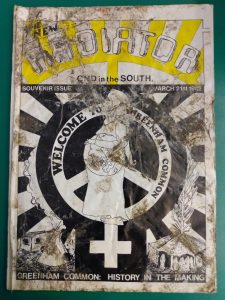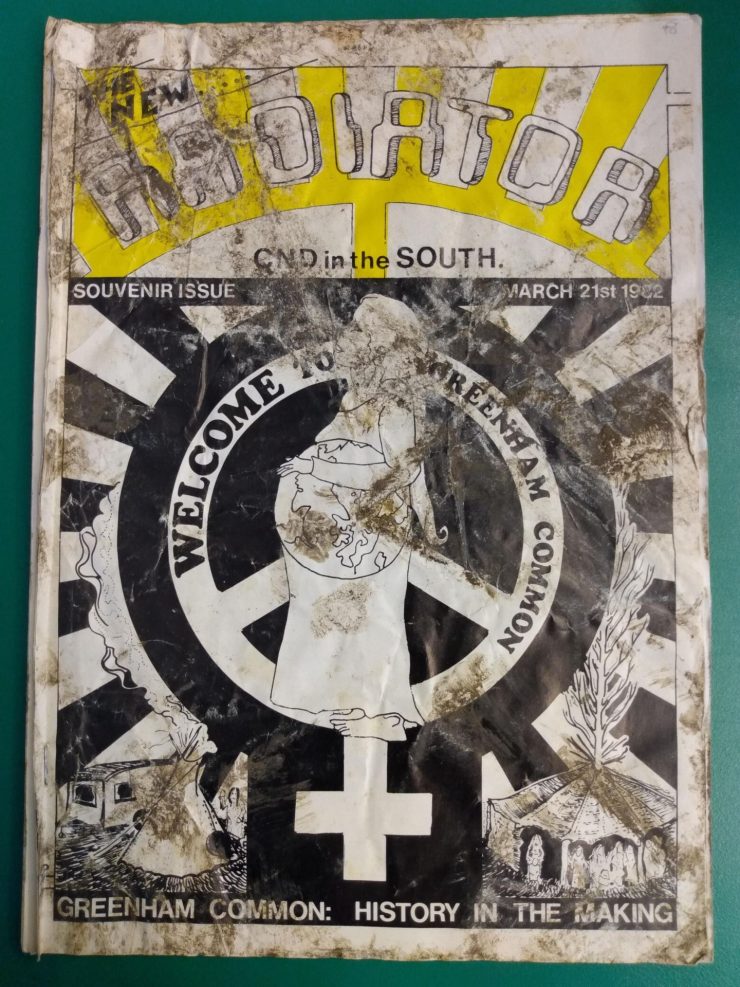The women’s peace camp at Greenham Common (1981-2000) was born out of fear of the prospect of nuclear war and frustration at the misguided wastefulness of the arms race. Private nightmares (Cook and Kirk 1983, 12) were transformed through feminist mobilisation into creative non-violent direct actions, a growing international network of feminist anti-nuclear activists, and a string of encampments around the United States Air Force (USAF) base at Greenham Common, a piece of common land that had been requisitioned by the Ministry of Defence during World War 2 and then lent to Britain’s American allies in the Cold War. With the threat of nuclear war looming again (https://www.icanw.org/will_putin_use_nuclear_weapons), revisiting Greenham makes good feminist sense: its sprawl across public and private archives, physical and digital records, academic and activist collections, both facilitates and complicates our retrospective access to the peace camp. In this blog post, I focus on a stained item from an important archive, chosen for its material eloquence and ambiguity.
DM Withers (2016, 848) argues that collecting and curating the archives of women’s movements is rarely a purely academic pursuit, since such “memory resources” cannot be classified as “historical evidence alone” but “examples of feminist cultural heritage”. Some hope of reactivation, if not concrete plans for it, similarly shadows the uses of such archives by researchers like myself, even though my relationship to the peace camp at Greenham Common is highly mediated and almost entirely academic. In this context, the definition of ‘academic’ as scholarly is haunted by the other meaning of the word in modern English: purely theoretical, with no impact, and unrelated to real life.

The New Radiator: Souvenir issue on Greenham Common, 21st March, 1982, from the MayDay Rooms Collection
My research into the visual, material, and activist cultures of the women’s peace camp at USAF Greenham Common led me to a transdisciplinary and ever-growing network of academic texts, published testimonials, and an archival sprawl of ephemera, correspondence, images, and even fence fragments among other material traces. An item that stood out, not because of what it was but thanks to its obvious damage, was a muddied copy of The New Radiator: Souvenir issue on Greenham Common, 21 March 1982. I found it among Gwyn Kirk’s papers at the MayDay Rooms, an ‘archive, resource and safe haven for social movements, experimental and marginal cultures and their histories’ (https://maydayrooms.org/). These papers were on the top of my list, not only because of the on-going political activism of the archive that hosts them, but also because Kirk is responsible, alongside Alice Cook, for a unique book that had already proved illuminating in my Greenham research. Greenham Women Everywhere: Dreams, Ideas and Actions from the Women’s Peace Movement (1983) is a slim, collectively authored and sparsely illustrated volume, albeit including now iconic photographs of Greenham actions such as woven spider webs by Pam Isherwood, among others. The book’s subtitle turns out to be a factual description rather than rhetoric: it includes actual nightmares about nuclear war by numerous women who explain their motivations for joining the peace camp, as well as stories and observations about activism from people on the ground. Dream narratives, thoughts, strategies and tactics bleed into one another in ways that question any implied hierarchy or even distinction in a book that must have functioned principally as a recruitment tool in the early years of its circulation. Although texts are attributed to their authors, they are not typographically separated from one another, making it difficult for the reader to find what’s written by whom, and to question, in the process, whether it really matters. Here, form is truly inextricable from content.
The inextricability of form and content, materiality and discourse, does not only shape Cook and Kirk’s book but also Kirk’s archive. With this in mind, I shouldn’t have been taken aback by the discovery of a muddied copy of this publication by CND South, the South England branch of the Campaign for Nuclear Disarmament. The cover of this special issue is dominated by the female symbol flanked by a tipee and a hut, in both of which the home fires are kept burning. On the female symbol is the inscription ‘Welcome to Greenham Common’, partly covered by the drawing of a very young white woman, placed between and a little above the two primeval dwellings, and who is literally barefoot and pregnant. What is missed in this cover – or, rather, what is covered up – is that Greenham Common complicated and unsettled the established maternalism of earlier women’s pacifism, not by turning its back on care, but by taking it out of the nuclear family, materially and ideologically. Greenham pioneered a revolution of and in care, by insisting on the right to survival outside of social reproduction, by dethroning the (“innocent”!) child as the privileged and assumed recipient of care, by foregrounding reciprocity and interdependence, and by decentring the human in the ecosystems that needed and deserved protection from nuclear violence. Its ecofeminist consciousness was expressed in the media and aesthetics of its time but, politically and conceptually, foreshadowed contemporary understandings of ecocide and how to stop it.
Published in the first few months of the peace camp, the issue is stained by the experience of a winter spent outdoors, but also marked by the ambivalent relationship between Greenham and the CND, at times supportive but also marred by misunderstandings, stereotyping, underestimation, and exclusion. Even though many Greenham women credit the CND as the foundation of their anti-nuclear activism (https://greenhamwomeneverywhere.co.uk/muswell-hill-women/), it is widely acknowledged that Greenham’s tactics, including its brave self-designation as a feminist space (as Sasha Roseneil has often explained, Greenham wasn’t feminist because it was women-only, but that it became women-only because it was feminist) were not always taken seriously nor met with approval by their anti-nuclear allies. In their attitude to Greenham, CND central and CND local groups did not see eye to eye, with the latter showing more sympathy and support (https://greenhamwomeneverywhere.co.uk/rebecca-mordan/ and https://greenhamwomeneverywhere.co.uk/lynette-edwell-2/).
It might seem jarring to represent Greenham by a neatly (originally!) printed publication that did not originate in the peace camp but outside it, rather than the hand-drawn, pasted together, and photocopied newsletters, leaflets, and posters by Greenham women. Anna Feigenbaum (2013, 2), among others, has rightly remarked on the significance and richness of the DIY print media of Greenham: “The poetry, cartoons, sketches, songs, intricate drawings and haphazard doodles generate images of Greenham as a place rich with creativity, spontaneity, political experimentation and self-reflexive thinking.” My chosen object is not worthier than Greenham-made zines, far from it, but it is the material manifestation of a fault line. I wonder whether this copy of The New Radiator would have been kept were it not muddied. At the peace camp mud mattered, as Greenham woman Nicky Edwards explores in her semi-autobiographical novel Mud, where the narrator reflects on her own ambivalence about NVDA (non-violent direct action) while researching a play about World War 1. This stained item manifests the tensions between mainstream anti-nuclear campaigning and Greenham’s anarchic feminism, captures something of my own ambivalence (https://amkokoli.wixsite.com/greenhamcommon/post/greenham-common-and-race-a-collection-of-resources-in-progress), as well as bearing a piece of the peace camp itself.
REFERENCES
Cook, Alice, and Gwyn Kirk (1983) Greenham Women Everywhere. London: Pluto Press.
Feigenbaum, Anna (2013) ‘Written in the Mud’, Feminist Media Studies, 13:1, 1-13, DOI: 10.1080/14680777.2011.647964
Withers, DM (2016) ‘Theorising the Women’s Liberation Movement as Cultural Heritage’, Women’s History Review, 25:5, 847-862, DOI: 10.1080/09612025.2015.1132871

